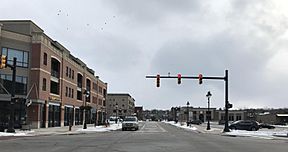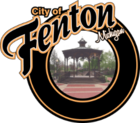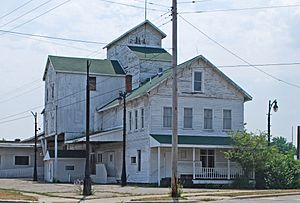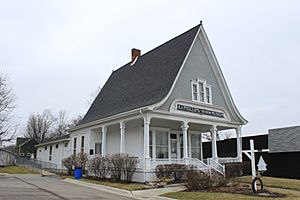Fenton, Michigan facts for kids
Quick facts for kids
Fenton, Michigan
|
|||||
|---|---|---|---|---|---|
| City of Fenton | |||||
|
Clockwise from top: Downtown Fenton; Fenton city hall; Shiawassee River
|
|||||
|
|||||

Location within Genesee County
|
|||||
| Country | United States | ||||
| State | Michigan | ||||
| Counties | Genesee, Livingston, and Oakland | ||||
| Settled | 1834 | ||||
| Incorporated | 1863 (village) 1964 (city) |
||||
| Named for | William M. Fenton | ||||
| Government | |||||
| • Type | Council–manager | ||||
| Area | |||||
| • Total | 6.97 sq mi (18.07 km2) | ||||
| • Land | 6.65 sq mi (17.23 km2) | ||||
| • Water | 0.32 sq mi (0.84 km2) 4.57% | ||||
| Elevation | 902 ft (275 m) | ||||
| Population
(2020)
|
|||||
| • Total | 12,050 | ||||
| • Density | 1,811.76/sq mi (699.49/km2) | ||||
| Demonym(s) | Fentonian, Fentonite | ||||
| Time zone | UTC-5 (Eastern (EST)) | ||||
| • Summer (DST) | UTC-4 (EDT) | ||||
| ZIP code(s) |
48430
|
||||
| Area code(s) | 248 and 810 | ||||
| FIPS code | 26-27760 | ||||
| GNIS feature ID | 0625893 | ||||
Fenton is a city in the U.S. state of Michigan that lies mostly in Genesee County, with small portions in neighboring Oakland and Livingston Counties. It is part of the Flint Metropolitan statistical area.
Contents
History
It was first established in 1834 and was originally named "Dibbleville" after Clark Dibble, one of the first settlers. It was platted in 1837 as "Fentonville" by William M. Fenton who later became lieutenant governor of Michigan. When the settlement was incorporated as a village in 1863 the name Fenton was used. The settlement's post office used the name Fentonville from 1837 until 1886, when it adopted the current name.
In the 1970s, the city leveled its downtown buildings and closed Leroy Street as part of an urban renewal plan. On August 24, 2007, an EF2 tornado hit Fenton, damaging several homes and a school, and almost completely destroying the soon to be opened Tractor Supply Company, tearing off its roof. This left many people without power, putting the city in a state of emergency. There were no fatalities or serious injuries. In July 2011, the first proposed building, Cornerstone, to restore the city's old downtown area was announced.
As of the 2010 census, the city population was 11,756. The city was incorporated from Fenton Township in Genesee County, and the city and township are administratively autonomous. Fenton includes several historic buildings. It was home to the first aviation school in Michigan and the A.J. Phillips Fenton Museum.
Geography
According to the United States Census Bureau, the city has an area of 7.00 square miles (18.13 km2), of which 6.68 square miles (17.30 km2) is land and 0.32 square miles (0.83 km2) (4.57%) is water.
Numerous municipalities in Michigan span two counties, but Fenton is one of two municipalities in Michigan to span three; the other is Lansing. The overwhelming majority of Fenton is in Genesee County, with a total area of 6.88 square miles (17.82 km2), of which 6.56 square miles (16.99 km2) is land and 0.32 square miles (0.83 km2) is water. The Genesee County portion represents 98.29% of Fenton's area and 99.99% of its population. Of Fenton's 11,747 residents, all but 10 live in Genesee County. The other 10 live in Fenton's Livingston County portion, which has a land area of 0.11 square miles (0.28 km2). A minuscule portion with no residents extends into Oakland County with a land area of 0.01 square miles (0.03 km2).
The Tipsico Lake Project is a brownfield redevelopment project to restore the land and surrounding area.
Demographics
| Historical population | |||
|---|---|---|---|
| Census | Pop. | %± | |
| 1860 | 735 | — | |
| 1870 | 2,353 | 220.1% | |
| 1880 | 2,152 | −8.5% | |
| 1890 | 2,182 | 1.4% | |
| 1900 | 2,408 | 10.4% | |
| 1910 | 2,331 | −3.2% | |
| 1920 | 2,507 | 7.6% | |
| 1930 | 3,171 | 26.5% | |
| 1940 | 3,377 | 6.5% | |
| 1950 | 4,226 | 25.1% | |
| 1960 | 6,142 | 45.3% | |
| 1970 | 8,284 | 34.9% | |
| 1980 | 8,098 | −2.2% | |
| 1990 | 8,444 | 4.3% | |
| 2000 | 10,582 | 25.3% | |
| 2010 | 11,756 | 11.1% | |
| 2020 | 12,050 | 2.5% | |
| U.S. Decennial Census | |||
2020 census
As of the census of 2020, there were 12,050 people, 5,025 households, and 3,060 families living in the city. The population density was 1,811.8 inhabitants per square mile (699.5/km2). The racial makeup of the city was 93% White, 1.6% African American, 0.5% Asian, and 4.7% from two or more races. Hispanic or Latino of any race were 5.1% of the population.
There were 5,025 households, of which 27.5% had children under the age of 18 living with them, 45.9% were married couples living together, 9.2% had a female householder with no husband present, 5.8% had a male householder with no wife present, and 39.1% were non-families. 34.5% of all households were made up of individuals, and 15.2% had someone living alone who was 65 years of age or older. The average household size was 2.34, and the average family size was 3.00.
The median age of the city was 38.2 years. 23.2% of residents were under the age of 18; 6.5% were between the ages of 18 and 24; 31.5% were from 25 to 44; 22.3% were from 45 to 64, and 16.4% were 65 years of age or older. The gender makeup of the city was 44.4% male and 55.6% female.
2010 census
As of the census of 2010, there were 11,756 people, 5,067 households, and 2,953 families living in the city. The population density was 1,759.9 inhabitants per square mile (679.5/km2). There were 5,572 housing units at an average density of 834.1 per square mile (322.0/km2). The racial makeup of the city was 95.1% White, 1.3% African American, 0.3% Native American, 0.7% Asian, 0.5% from other races, and 2.0% from two or more races. Hispanic or Latino of any race were 2.5% of the population.
There were 5,067 households, of which 31.9% had children under the age of 18 living with them, 39.8% were married couples living together, 13.2% had a female householder with no husband present, 5.2% had a male householder with no wife present, and 41.7% were non-families. 34.9% of all households were made up of individuals, and 13.5% had someone living alone who was 65 years of age or older. The average household size was 2.27 and the average family size was 2.96.
The median age in the city was 36 years. 24.1% of residents were under the age of 18; 8.9% were between the ages of 18 and 24; 29.7% were from 25 to 44; 22.8% were from 45 to 64, and 14.4% were 65 years of age or older. The gender makeup of the city was 46.8% male and 53.2% female.
Infrastructure
Schools
World of Wonder
North Road Elementary State Road Elementary Tomek Elementary
Andrew G. Schmidt Middle School
Fenton High School
Highways
US Highway 23 runs north and south through the west side of the city as a freeway. The original routing of US 23 ran northeast along Shiawassee Avenue to Leroy Street, then north along Leroy to the northern edge of the city. The portion of old US 23 south of Silver Lake Road, along with Silver Lake Road itself west back to US 23, was designated a business route of US 23 in 1958, before being removed as a state trunkline in 2006.
Utilities
The municipality operates its own water system.
Notable people
- Cynthia Roberts Gorton (1826–1894), blind poet and author
- Ira W. Jayne (1882–1961), Wayne County Circuit Court Chief Judge
See also
 In Spanish: Fenton (Míchigan) para niños
In Spanish: Fenton (Míchigan) para niños











